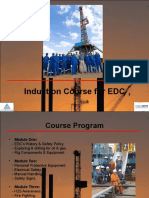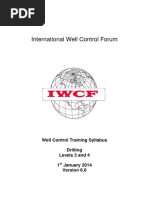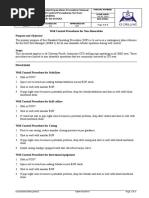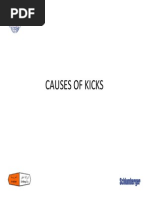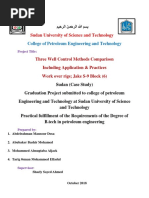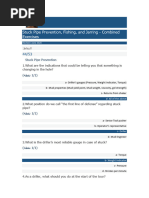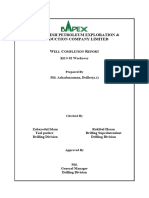18 Well Control
18 Well Control
Uploaded by
Abdulqawi RazazzCopyright:
Available Formats
18 Well Control
18 Well Control
Uploaded by
Abdulqawi RazazzOriginal Description:
Copyright
Available Formats
Share this document
Did you find this document useful?
Is this content inappropriate?
Copyright:
Available Formats
18 Well Control
18 Well Control
Uploaded by
Abdulqawi RazazzCopyright:
Available Formats
Exit
Chapter Table of Contents
Index
Handbook Table of Contents
Topic Page
Menu
18
Well control
Contents
Overview . . . . . . . . . . . . . . . . . . . . . . . . . . . . . . . . . . . . . . . . . . . . 18-2 Kicks . . . . . . . . . . . . . . . . . . . . . . . . . . . . . . . . . . . . . . . . . . . . . . . 18-2 Controlling a kick . . . . . . . . . . . . . . . . . . . . . . . . . . . . . . . . . . . 18-3 Shut-in procedures . . . . . . . . . . . . . . . . . . . . . . . . . . . . . . . . . . . . 18-3 Kill methods . . . . . . . . . . . . . . . . . . . . . . . . . . . . . . . . . . . . . . . . . 18-3 Wait-and-weight method . . . . . . . . . . . . . . . . . . . . . . . . . . . . . 18-3 Driller's method . . . . . . . . . . . . . . . . . . . . . . . . . . . . . . . . . . . . 18-4 Concurrent method . . . . . . . . . . . . . . . . . . . . . . . . . . . . . . . . . . 18-4 Kick control problems . . . . . . . . . . . . . . . . . . . . . . . . . . . . . . . . . 18-7
CHAPTER
Exit
Chapter Table of Contents
Index
Handbook Table of Contents
Topic Page
Well control
Overview
This section explains kicks, warning signs, and kick control. Shut-in procedures and common kill methods are explained, and the steps to accomplish each are provided. Common kill problems are identified, and the solutions for these problems are given.
Kicks
A kick is an influx of formation fluids into the wellbore. Some of the conditions that can induce a kick are: C C C C C Drilling into an abnormally pressured formation Failure to keep the hole full during trips Insufficient mud weight Lost circulation Swab/Surge pressures
Warning signs of a kick include: C C C C C C C Drilling breaks Increase in pit volume Increase in mud-return flow rate Flow with the mud pumps off Pump-pressure decrease and stroke-rate increase Drilling reversal Hole not taking proper fluid volume during a trip
18-2
Exit
Chapter Table of Contents
Index
Handbook Table of Contents
Topic Page
Baroid fluids handbook
Controlling a kick
Follow this procedure to control a kick: 1. 2. 3. 4. 5. 6. 7. Pull off bottom. Shut off pumps. Check for flow. Shut-in the well. Record pressures. Kill the well. Verify that the well is dead.
Note: The best indication that a well has been killed is when the choke is open 100 percent and there is no flow.
Shut-in procedures
A shut-in procedure can be either soft or hard. When conducting a soft shut-in the choke is partially to fully open when the annular preventer is closed. When conducting a hard shut-in the choke is fully closed when the annular preventer is closed.
Kill methods
Three basic techniques used to kill a well are: C C C Wait-and-weight method Driller's method Concurrent method
Wait-andweight method
The most widely used kill method is wait-and-weight. In this method, the well is shut-in, and the surface system is weighted up to the required kill weight. The weighted mud is pumped into the well, and the kick is killed in one complete circulation. This method is also called the engineer's or one-circulation method.
Revised August 1, 1997
18-3
Exit
Chapter Table of Contents
Index
Handbook Table of Contents
Topic Page
Well control
Driller's method
In the second kill method, the influx is pumped out of the wellbore after recording the shut-in pressures and pit volume increase, but before weighting up the drilling fluid. Once the influx has been pumped out of the well, the well is shut-in and the surface mud system is weighted up to the required kill weight. This procedure is also called the two-circulation method.
Concurrent method
The third kill method requires weighting up the surface system while circulating out the influx. Once kill weight has been pumped to the bit, then final circulating pressure is maintained on the drill pipe gauge until the influx is out of the wellbore and kill weight mud is returning at the surface. Kill sheet. Complete the prerecorded and recorded information sections. Then calculate the kill weight mud and the initial and final circulating pressures. See Figures 18-1 and 18-2 for an example of a kill sheet.
18-4
Exit
Chapter Table of Contents
Index
Handbook Table of Contents
Topic Page
Baroid fluids handbook
PRE-RECORDED INFORMATION
Pump No.1 Pump No 2
Original Mud Weight (OMW) _____ lb/gal True Vertical Depth (TVD) _____ ft Measured Depth (MD) _____ ft
Surface to Bit ___ bbls ___ stks ___ stks Bit to Surface ___ bbls ___ stks ___ stks Totals ___ bbls ___ stks ___ stks Pump No. 2 _____ bbl/stk KRS _____ spm KRS _____ spm MACP _____ psi KRP _____ psi KRP _____ psi
Pump No. 1 _____ bbl/stk KRS _____ spm KRS _____ spm SHOE: Test _____ lb/gal KRP _____ psi KRP _____ psi Depth _____ ft
Bit to Shoe _____
RECORDED INFORMATION
SIDPP _______ psi SICP _______ psi Pit Gain _______
KILL CALCULATIONS
Kill Weight Mud (KWM) =
SIDPP ( ) + OMW: 0.052 x TVD 0.052 x (
( )
+ ( + (
) = ____ ) = ____ psi ) = ____ psi
Initial Circulating Pressure (ICP) = SIDPP + KRP: Final Circulating Pressure (FCP) =
KWM x KRP: OMW
( (
) )
x (
Figure 18-1: Sample kill sheet. The top half of a kill sheet is a work sheet for necessary kill calculations.
Where C C C C C C C C C C C OMW is the original mud weight (lb/gal) TVD is the true vertical depth (ft) MD is the measured depth (ft) stks is strokes spm is strokes per minute KRS is the kill rate speed (spm) KRP is kill rate pressure (psi) MACP is the maximum allowable casing pressure (psi) SIDPP is the shut in drill pipe pressure (psi) SICP is the shut in casing pressure (psi) KWM is kill weight mud (lb/gal)
Revised August 1, 1997
18-5
Exit
Chapter Table of Contents
Index
Handbook Table of Contents
Topic Page
Well control
PRESSURE SCHEDULE
INITIAL CIRCULATING PRESSURE
FINAL CIRCULATING PRESSURE
Pump Strokes Drill Pipe Pressure
Figure 18-2: Sample kill sheet, continued. Using the values derived from the kill sheet calculations, plan the pressure relief schedule.
18-6
Exit
Chapter Table of Contents
Index
Handbook Table of Contents
Topic Page
Baroid fluids handbook
Kick control problems
While controlling a kick, some of the problems that can occur include: C C C C C C C C Lost circulation Plugged jets Washed-out choke Plugged choke Washout in the drillstring Gas migration Off-bottom bit Gas hydrate formation
These problems can result from the increased pressure and heavy kill-weight mud. In some cases, more than one problem can occur. Use Table 18-1 to determine the source of problems during a kill procedure.
Indication Situation
Total circulation loss Partial circulation loss Choke plugging Jet plugging Choke washout Drillstring washout
Drillpipe pressure
Major decrease Major decrease Major increase Major increase Major decrease Major decrease
Casing pressure
Major decrease Decrease Major increase No change Major decrease No change
Pump rate
Increase Increase Decrease Decrease Increase Increase
Table 18-1: Kill procedure problem indicators. Use these guidelines to quickly identify problems in well-control situations.
Solutions for dealing with a lost circulation problem are detailed in the chapter titled Lost circulation.
Revised August 1, 1997
18-7
You might also like
- AC-0087 Primary Centre Accreditation GuidanceNo ratings yetAC-0087 Primary Centre Accreditation Guidance16 pages
- Underbalanced Coiled Tubing Drilled Horizontal Well in The North SeaNo ratings yetUnderbalanced Coiled Tubing Drilled Horizontal Well in The North Sea6 pages
- Evaluation of Activity Coefficient Using VLE Data100% (1)Evaluation of Activity Coefficient Using VLE Data109 pages
- Formation Testing: Supercharge, Pressure Testing, and Contamination ModelsFrom EverandFormation Testing: Supercharge, Pressure Testing, and Contamination ModelsNo ratings yet
- Internship Report On Well Control MethodsNo ratings yetInternship Report On Well Control Methods18 pages
- DXXXX-QSOP - Well Control Procedures For Non-ShearablesNo ratings yetDXXXX-QSOP - Well Control Procedures For Non-Shearables3 pages
- WSL - Standing Orders - 7dec 2015 - 4924177 - 01 PDFNo ratings yetWSL - Standing Orders - 7dec 2015 - 4924177 - 01 PDF48 pages
- Improving The Accuracy of Mechanical Backoff in Stuck Pipe Situation During DrillingNo ratings yetImproving The Accuracy of Mechanical Backoff in Stuck Pipe Situation During Drilling9 pages
- IWCF - Sample Questions - Principles & ProceduresNo ratings yetIWCF - Sample Questions - Principles & Procedures11 pages
- Standard Operating Procedure - Cementing: 1. Purpose100% (1)Standard Operating Procedure - Cementing: 1. Purpose4 pages
- Sjs Mechanical Setting Tool and MMR Cement RetainerNo ratings yetSjs Mechanical Setting Tool and MMR Cement Retainer43 pages
- Prepared By: Touseef Ur Rehman Petroleum & Gas Engineer100% (1)Prepared By: Touseef Ur Rehman Petroleum & Gas Engineer22 pages
- WELL: HH 83/1D: WIND SPEED at 6:00 AM 44-46 KNTS. (N-NW)No ratings yetWELL: HH 83/1D: WIND SPEED at 6:00 AM 44-46 KNTS. (N-NW)5 pages
- Lecture # 2 Sept 8, 2020: Artificial Lift Technology Quizzes QuestionsNo ratings yetLecture # 2 Sept 8, 2020: Artificial Lift Technology Quizzes Questions3 pages
- IRP 22 - Underbalanced Drilling & Managed Pressure Drilling Operations Using Jointed Pipe - Oct 17 - 2018 PDFNo ratings yetIRP 22 - Underbalanced Drilling & Managed Pressure Drilling Operations Using Jointed Pipe - Oct 17 - 2018 PDF158 pages
- Hard Shut-In Procedure - Drilling Fixed RigNo ratings yetHard Shut-In Procedure - Drilling Fixed Rig6 pages
- Well Killing: BY: Naga Ramesh D. Assistant Professor Petroleum Engineering Dept. KlefNo ratings yetWell Killing: BY: Naga Ramesh D. Assistant Professor Petroleum Engineering Dept. Klef11 pages
- Presentation - Bit - 001 - IntroductionNo ratings yetPresentation - Bit - 001 - Introduction15 pages
- Trip Sheet (RIH) : Presented by "Petroleum Capsules" ChannelNo ratings yetTrip Sheet (RIH) : Presented by "Petroleum Capsules" Channel5 pages
- Baghjan Well No. 5 Blowout: Sequence of EventsNo ratings yetBaghjan Well No. 5 Blowout: Sequence of Events3 pages
- Physicochemical Properties of Banana Peel Flour As Influenced by Variety and Stage of Ripeness Multivariate Statistical AnalysisNo ratings yetPhysicochemical Properties of Banana Peel Flour As Influenced by Variety and Stage of Ripeness Multivariate Statistical Analysis14 pages
- Properties of High Strenght Concrete Subjet To Short Terms LoadsNo ratings yetProperties of High Strenght Concrete Subjet To Short Terms Loads7 pages
- Summary of Capability Laboratory Test of Cement: Smcc-Itd JVNo ratings yetSummary of Capability Laboratory Test of Cement: Smcc-Itd JV1 page
- Commonly Occuring Anti-Nutrients & Toxicants in Feed IngredientsNo ratings yetCommonly Occuring Anti-Nutrients & Toxicants in Feed Ingredients30 pages
- Transcutol Aplicaciones Industria Del Cuidado Personal100% (1)Transcutol Aplicaciones Industria Del Cuidado Personal24 pages
- Training Report of IFFCO KALOL - Daxit AkbariNo ratings yetTraining Report of IFFCO KALOL - Daxit Akbari45 pages
- Study of Cellwall Constituents and Cell Inclusions73% (11)Study of Cellwall Constituents and Cell Inclusions42 pages
- LIBROS - SIEMENS - Medicion en Liquidos de Procesos PDFNo ratings yetLIBROS - SIEMENS - Medicion en Liquidos de Procesos PDF379 pages
- 2017 Supplement Guide: Muscle Building, Strength, RecoveryNo ratings yet2017 Supplement Guide: Muscle Building, Strength, Recovery14 pages
- Analysis of Reinforced Concrete Column Using FRP Composites: Vikrant S Vairagade, Dr. Shrikrishna Dhale, Dr. Patel RakeshNo ratings yetAnalysis of Reinforced Concrete Column Using FRP Composites: Vikrant S Vairagade, Dr. Shrikrishna Dhale, Dr. Patel Rakesh3 pages
- Automated Titration of The Hydroxyl Number According To ASTM E1899 and EN ISO 4629-2No ratings yetAutomated Titration of The Hydroxyl Number According To ASTM E1899 and EN ISO 4629-28 pages
- D93 Flash Point by Pensky-Martens Closed Cup Tester PDFNo ratings yetD93 Flash Point by Pensky-Martens Closed Cup Tester PDF18 pages
- Effect of By-Product Steel Slag On The Engineering Properties of Clay SoilsNo ratings yetEffect of By-Product Steel Slag On The Engineering Properties of Clay Soils6 pages
- Underbalanced Coiled Tubing Drilled Horizontal Well in The North SeaUnderbalanced Coiled Tubing Drilled Horizontal Well in The North Sea
- Formation Testing: Supercharge, Pressure Testing, and Contamination ModelsFrom EverandFormation Testing: Supercharge, Pressure Testing, and Contamination Models
- DXXXX-QSOP - Well Control Procedures For Non-ShearablesDXXXX-QSOP - Well Control Procedures For Non-Shearables
- WSL - Standing Orders - 7dec 2015 - 4924177 - 01 PDFWSL - Standing Orders - 7dec 2015 - 4924177 - 01 PDF
- Improving The Accuracy of Mechanical Backoff in Stuck Pipe Situation During DrillingImproving The Accuracy of Mechanical Backoff in Stuck Pipe Situation During Drilling
- Standard Operating Procedure - Cementing: 1. PurposeStandard Operating Procedure - Cementing: 1. Purpose
- Sjs Mechanical Setting Tool and MMR Cement RetainerSjs Mechanical Setting Tool and MMR Cement Retainer
- Prepared By: Touseef Ur Rehman Petroleum & Gas EngineerPrepared By: Touseef Ur Rehman Petroleum & Gas Engineer
- WELL: HH 83/1D: WIND SPEED at 6:00 AM 44-46 KNTS. (N-NW)WELL: HH 83/1D: WIND SPEED at 6:00 AM 44-46 KNTS. (N-NW)
- Lecture # 2 Sept 8, 2020: Artificial Lift Technology Quizzes QuestionsLecture # 2 Sept 8, 2020: Artificial Lift Technology Quizzes Questions
- IRP 22 - Underbalanced Drilling & Managed Pressure Drilling Operations Using Jointed Pipe - Oct 17 - 2018 PDFIRP 22 - Underbalanced Drilling & Managed Pressure Drilling Operations Using Jointed Pipe - Oct 17 - 2018 PDF
- Well Killing: BY: Naga Ramesh D. Assistant Professor Petroleum Engineering Dept. KlefWell Killing: BY: Naga Ramesh D. Assistant Professor Petroleum Engineering Dept. Klef
- Trip Sheet (RIH) : Presented by "Petroleum Capsules" ChannelTrip Sheet (RIH) : Presented by "Petroleum Capsules" Channel
- Physicochemical Properties of Banana Peel Flour As Influenced by Variety and Stage of Ripeness Multivariate Statistical AnalysisPhysicochemical Properties of Banana Peel Flour As Influenced by Variety and Stage of Ripeness Multivariate Statistical Analysis
- Properties of High Strenght Concrete Subjet To Short Terms LoadsProperties of High Strenght Concrete Subjet To Short Terms Loads
- Summary of Capability Laboratory Test of Cement: Smcc-Itd JVSummary of Capability Laboratory Test of Cement: Smcc-Itd JV
- Commonly Occuring Anti-Nutrients & Toxicants in Feed IngredientsCommonly Occuring Anti-Nutrients & Toxicants in Feed Ingredients
- Transcutol Aplicaciones Industria Del Cuidado PersonalTranscutol Aplicaciones Industria Del Cuidado Personal
- Study of Cellwall Constituents and Cell InclusionsStudy of Cellwall Constituents and Cell Inclusions
- LIBROS - SIEMENS - Medicion en Liquidos de Procesos PDFLIBROS - SIEMENS - Medicion en Liquidos de Procesos PDF
- 2017 Supplement Guide: Muscle Building, Strength, Recovery2017 Supplement Guide: Muscle Building, Strength, Recovery
- Analysis of Reinforced Concrete Column Using FRP Composites: Vikrant S Vairagade, Dr. Shrikrishna Dhale, Dr. Patel RakeshAnalysis of Reinforced Concrete Column Using FRP Composites: Vikrant S Vairagade, Dr. Shrikrishna Dhale, Dr. Patel Rakesh
- Automated Titration of The Hydroxyl Number According To ASTM E1899 and EN ISO 4629-2Automated Titration of The Hydroxyl Number According To ASTM E1899 and EN ISO 4629-2
- D93 Flash Point by Pensky-Martens Closed Cup Tester PDFD93 Flash Point by Pensky-Martens Closed Cup Tester PDF
- Effect of By-Product Steel Slag On The Engineering Properties of Clay SoilsEffect of By-Product Steel Slag On The Engineering Properties of Clay Soils





